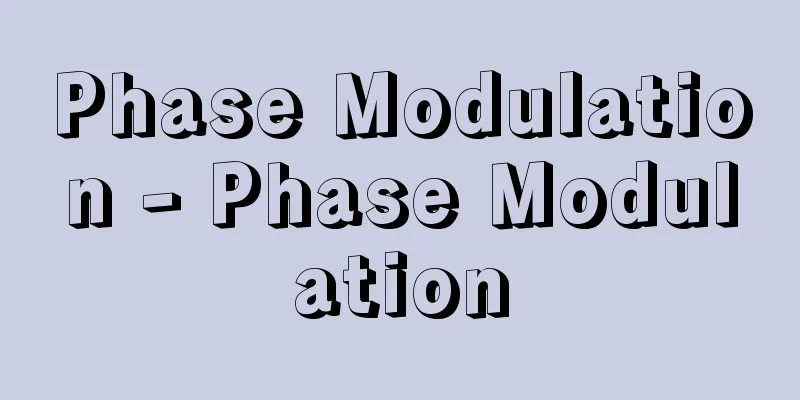Phase Modulation - Phase Modulation

|
A modulation method in telecommunications, which changes the phase of a carrier wave according to changes in the signal current. It is also called PM (short for phase modulation). Modulation refers to giving a certain change to a communication carrier wave that corresponds to the signal current to be transmitted. A carrier wave is usually a sine wave with a frequency two or more orders of magnitude higher than the signal frequency, and phase modulation is a modulation method that changes the phase of this sine wave, especially among the three elements of amplitude, frequency, and phase. The phase of the carrier wave is changed by up to 180 degrees depending on the data to be transmitted. Traditionally, it was treated as a type of frequency modulation (FM, short for frequency modulation) and was not given much importance, but since around 1970, it has been used as phase shift keying (PSK, short for phase shift keying) for digital data communication (weather satellites, earth observation satellites, etc.). Furthermore, by using the n- phase PSK method, which changes the phase not only to two phases but also to four, eight, and 16 phases, it has succeeded in increasing the information transmission capacity by two, four, or eight times, thereby increasing the information transmission speed. Also, although it is not simply called phase modulation, a modulation method that changes the amplitude and phase of the three elements of the carrier wave, for example, is called quadrature amplitude modulation (QAM), and is intended to further increase information transmission speed. This method has a wider bandwidth than simple phase modulation, so it is suitable for broadband communication lines such as satellite communication lines and optical communication lines, and is a system that dramatically improves information transmission capacity, such as 16QAM, 64QAM, and 256QAM. And as the transmission speed of digital signals increases, it is now possible to easily transmit high-speed analog signals such as television images by digitally encoding them, which was previously not suitable for phase modulation. [Iwao Ishijima] [Reference] | | |Source: Shogakukan Encyclopedia Nipponica About Encyclopedia Nipponica Information | Legend |
|
電気通信における変調方式の一つで、信号電流の変化に応じて、搬送波の位相に変化を与えることをいう。PM(phase modulationの略称)ともいう。通信用の搬送波に、送信しようとする信号電流に対応するある種の変化を与えることを変調という。搬送波は通常、信号周波数より2桁(けた)以上高い周波数の正弦波を使用するが、この正弦波の振幅、周波数、位相の3要素のうち、とくに位相に変化を与える変調方式が位相変調である。伝送するデータによって搬送波の位相を最大限180度変化させる。従来は周波数変調(FM=frequency modulationの略称)の一種として扱われ、あまり重視されなかったが、1970年ごろから位相偏移変調(PSK=phase shift keyingの略称)として、デジタル方式によるデータ通信(気象衛星、地球観測衛星など)に利用されるようになった。さらに位相の変化を2相だけでなく、4相、8相、16相のように変化させるn相PSK方式の使用によって、情報伝送容量の2倍、4倍、8倍の増強に成功して情報伝送速度が高速化した。また、単純に位相変調とはいえないが、その範疇(はんちゅう)に入る技術として、搬送波の3要素のなかの、たとえば振幅と位相に変化を与えるような変調方式を直交振幅変調(QAM=quadrature amplitude modulationの略称)と称して、さらなる情報伝送速度の増強を図っている。この方式は、単純な位相変調よりも帯域が広がるため、衛星通信回線や光通信回線のようなブロードバンドの通信回線に適し、16QAM、64QAM、256QAMのように情報伝送容量が飛躍的に向上するシステムとなっている。そして、デジタル信号の伝送速度が高速化するにしたがって、従来、位相変調では不得意とされていた、テレビ映像のような高速度のアナログ信号の伝送も、デジタル符号化して容易に伝送することが可能となっている。 [石島 巖] [参照項目] | | |出典 小学館 日本大百科全書(ニッポニカ)日本大百科全書(ニッポニカ)について 情報 | 凡例 |
Recommend
legion étrangère (English spelling) legionetrangere
…The origins of the Foreign Legion can be traced ...
Olivenite - Olivenite (English spelling)
A hydrous cupric arsenate mineral. As suggested b...
Kuang-tai-xie-xue (English: The science of evil and wickedness)
This is a term used by the Chinese literati critic...
Inshi (worship) - Inshi
...a folk belief or religion that was deemed by t...
marginal productivity theory
...Both of the above theories were developed with...
Aketoaten - Aketoaten
…The site of the capital of the 18th Dynasty refo...
One-shot answer method - Ippa-kaitouhoshiki
...Since then, under this power, they have propos...
Surinam toad (babysitter frog)
Also known as Pipa. A frog of the Pipa family (ill...
Primary product problem
Generally, primary commodities refer to agricultur...
Takitaro Minakami - Takitaro Minakami
Novelist, critic, and playwright. Born in Tokyo o...
Shinjo clan
A feudal lord in the early modern period. He is sa...
Swing
A type of rocking playground equipment. A typical...
Heroic Age Theory
...In this case, the heroes were none other than ...
Panaji
...area: 3,702 km2, population: 1.17 million (199...
longitudinal valley
A valley is a type of valley that crosses a mount...









